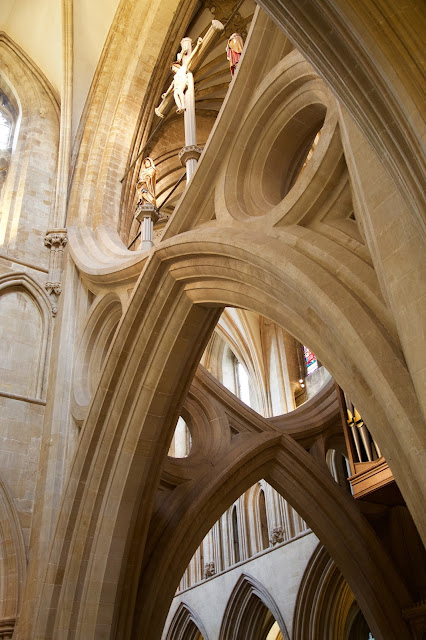This was a busy day. Leaving Apsley House at 10am, the plan was to drive to
Wells Cathedral, Cheddar Grove, Glastonbury Abbey, Nunney Castle and then return to Wells Cathedral to hear the evensong service, followed by dinner in Wells.
The drive through the countryside was beautiful. As we've been driving through the UK, we noticed that it takes a longer time to cover a short distance, compared to US driving. Largely due to narrow country roads and passing through small villages, we constantly adjusted our speed from 20 to 50mph. With this in mind, we started to revise our day-trip destinations to require no more than about 90 minutes out and 90 minutes for the drive back to our B&B.
Wells Cathedral
We enjoyed seeing the wonderful architectural structure of the cathedral, the stained glass and life-like carved structures. Wells Cathedral is dedicated to St Andrew the Apostle. Evidence has been found at the church of an early abbey church built in 700. The present gothic style church was built from 1175 to 1490. Restoration work on the cathedral was completed between 1976 and 1984. The church's Lady Chapel has large stained glass panels dating from 1325 to 1330. Some of the glass panel sections have been restored and appear confused.
After our visit, we stopped for a mid-morning coffee/juice and a slice of almond cake at the cathedral cafe before heading on.
After our visit to Glastonbury Abbey, we arrived back at Wells just in time to attend the last half of the evensong service, sung by the mens and boys choir.
 |
| © 2015, R. Ono |
 |
| © 2015, R. Ono |
 |
| © 2015, R. Ono |
 |
| © 2015, R. Ono |
Nunney
This was the castle of an up and coming knight in the 1300s. Unfortunately, it was shelled in the 1500s and only the castle shell exists today. Nonetheless, it was interesting to view the castle and you could see indications of the location of floors and stairs. The Nunney village was also quite charming.
 |
| © 2015, R. Ono |
 |
© 2015, R. Ono
|
 |
| © 2015, R. Ono |
 |
| © 2015, R. Ono |
 |
| © 2015, R. Ono |
Glastonbury Abbey
After parking, we struggled to find the entry gates. We walked almost completely around the abbey grounds before we found the entry into the park. It was amazing to see the remnants of the Glastonbury Abbey, the damage being the result of the reformation and Henry VIII.
At one time, the tomb of King Arthur and Queen Guinevere was reportedly found in Glastonbury Abbey. The story told is that King Arthur was mortally wounded at the battle of Camlann and taken to the abbey for medical care. The abbey monks located the grave in 1191, containing a huge oak coffin, with the inscription of "Here lives King Arthur buried in Avalon." The bodies of a man and woman were in the coffin. The coffin was later moved but location records were ultimately lost.
How was King Arthur wounded? There are several legends. One version indicates that while King Arthur was pursuing Sir Lancelot in France, after discovery of the affair between Guinevere and Lancelot, Mordred assumed responsibility for Britain. Mordred, either a traitor or opportunist, refused to give up the throne when King Arthur returned to Britain. King Arthur fought against Mordred and fell during the battle of Camlann. Arthur supposedly was brought to Avalon, for its magical healing powers, but died there. Another legend version reports that King Arthur was fighting in Rome and not necessarily pursuing Sir Lancelot. The former version is certainly more romantic. In the battle of Camlann, King Arthur and Mordred were both mortally wounded.
 |
| © 2015, R. Ono |
 |
| © 2015, R. Ono |
 |
| © 2015, R. Ono |
 |
| © 2015, R. Ono |
 |
| © 2015, R. Ono |
 |
| © 2015, R. Ono |
I


























No comments:
Post a Comment